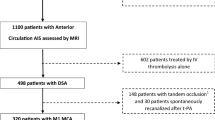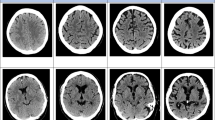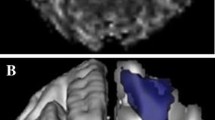Abstract
Background
To explore whether temporal lobe atrophy predicts 3-month functional outcome in a population of patients with anterior circulation acute ischemic stroke (AIS) treated with mechanical thrombectomy (MT).
Methods
We retrospectively selected patients > 65 years from our prospective endovascular stroke registry between June 2013 and August 2018. According to 3-month modified Rankin Scale (mRS), patients were divided in two groups, named good (mRS ≤ 2) and poor (mRS > 2) outcome. Measures of temporal lobe atrophy (i.e., interuncal distance [IUD], medial temporal lobe thickness [mTLT] and radial width of temporal horn [rWTH]) were assessed on pre-treatment CT scan. Cutoff values for good outcome were obtained for IUD, mTLT and rWTH by means of non-parametric ROC curve analysis. Multivariate analysis was performed to identify predictors of outcome. Ordinal shift analysis based on cutoff values was built to evaluate differences in 3-month mRS.
Results
Among 340 patients, 130 (38.2%) had good and 210 (61.8%) had poor outcome. We found the following cutoff values for good outcome: < 25 mm for IUD, > 15 mm for mTLT and < 4 mm for rWTH. Lower IUD (OR 0.71; 95% CI 0.63–0.80; p < 0.0001) and rWTH (OR 0.73; 95% CI 0.61–0.87; p < 0.0001) and higher mTLT (OR 1.30; 95% CI 1.14–1.49; p < 0.0001) were independently associated with good outcome. Ordinal shift analysis based on cutoff values revealed significant differences in the rate of good outcome for rWTH (49 vs 27%; p < 0.0001), mTLT (52 vs 21%; p < 0.0001) and IUD (57 vs 17%; p < 0.0001).
Conclusions
Assessment of temporal lobe atrophy may predict functional outcome in patients with AIS treated with MT.


Similar content being viewed by others
Data availability
The data that support the findings of this study are available upon reasonable request from any qualified investigator.
References
Berkhemer OA et al (2015) A randomized trial of intraarterial treatment for acute ischemic stroke. N Engl J Med 372(1):11–20
Goyal M et al (2015) Randomized assessment of rapid endovascular treatment of ischemic stroke. N Engl J Med 372(11):1019–1030
Saver JL et al (2015) Stent-retriever thrombectomy after intravenous t-PA vs. t-PA alone in stroke. N Engl J Med 372(24):2285–2295
Nogueira RG et al (2018) Thrombectomy 6 to 24 hours after stroke with a mismatch between deficit and infarct. N Engl J Med 378(1):11–21
Albers GW et al (2018) Thrombectomy for stroke at 6 to 16 hours with selection by perfusion imaging. N Engl J Med 378(8):708–718
van den Berg LA et al (2017) Two-year outcome after endovascular treatment for acute ischemic stroke. N Engl J Med 376(14):1341–1349
Sallustio F et al (2019) Selection of anterior circulation acute stroke patients for mechanical thrombectomy. J Neurol 266(11):2620–2628
Wakisaka Y et al (2017) Adverse influence of pre-stroke dementia on short-term functional outcomes in patients with acute ischemic stroke: the Fukuoka stroke registry. Cerebrovasc Dis 43(1–2):82–89
Powers WJ et al (2019) Guidelines for the early management of patients with acute ischemic stroke: 2019 update to the 2018 guidelines for the early management of acute ischemic stroke: a guideline for healthcare professionals from the American heart association/American stroke association. Stroke 50(12):e344–e418
Ouchi Y et al (2017) Redefining the elderly as aged 75 years and older: proposal from the joint committee of japan gerontological society and the japan geriatrics society. Geriatr Gerontol Int 17(7):1045–1047
Drayer BP (1988) Imaging of the aging brain Part I normal findings. Radiology 166(3):785–796
Frodl T et al (2006) Reduced hippocampal volume correlates with executive dysfunctioning in major depression. J Psychiatry Neurosci 31(5):316–325
Nickl-Jockschat T et al (2012) Neuroanatomic changes and their association with cognitive decline in mild cognitive impairment: a meta-analysis. Brain Struct Funct 217(1):115–125
Leandrou S, Lamnisos D, Mamais I, Kyriacou PA, Pattichis CS, Alzheimer’s Disease and Neuroimaging Initiative (2020) Assessment of Alzheimer’s disease based on texture analysis of the entorhinal cortex. Front Aging Neurosci. 2(12):176
Fein G et al (2000) Hippocampal and cortical atrophy predict dementia in subcortical ischemic vascular disease. Neurology 55(11):1626–1635
Elkins JS, Longstreth WT Jr, Manolio TA, Newman AB, Bhadelia RA, Johnston SC (2006) Education and the cognitive decline associated with MRI-defined brain infarct. Neurology 67(3):435–440
Mok VCT, Lam BYK, Wong A, Ko H, Markus HS, Wong LKS (2017) Early-onset and delayed-onset poststroke dementia—revisiting the mechanisms. Nat Rev Neurol 13(3):148–159
Gemmell E, Bosomworth H, Allan L et al (2011) Hippocampal neuronal atrophy and cognitive function in delayed poststroke and aging-related dementias. Stroke 43(3):808–814
Kliper E, Bashat DB, Bornstein NM et al (2013) Cognitive decline after stroke: relation to inflammatory biomarkers and hippocampal volume. Stroke 44(5):1433–1435
Hénon H, Pasquier F, Durieu I, Pruvo JP, Leys D (1998) Medial temporal lobe atrophy in stroke patients: relation to pre-existing dementia. J Neurol Neurosurg Psychiatry 65(5):641–647
Pirson FAV et al (2022) Endovascular treatment for posterior circulation stroke in routine clinical practice: results of the multicenter randomized clinical trial of endovascular treatment for acute ischemic stroke in the Netherlands registry. Stroke 53(3):758–768
Adams HP Jr et al (1993) Classification of subtype of acute ischemic stroke: definitions for use in a multicenter clinical trial: TOAST: trial of org 10172 in acute stroke treatment. Stroke 24:35–41
Pexman JH et al (2001) Use of the Alberta stroke program early CT score (ASPECTS) for assessing CT scans in patients with acute stroke. AJNR Am J Neuroradiol 22(8):1534–1542
Sallustio F et al (2017) CT angiography ASPECTS predicts outcome much better than noncontrast CT in patients with stroke treated endovascularly. AJNR Am J Neuroradiol 38(8):1569–1573
Sallustio F et al (2017) CT angiography-based collateral flow and time to reperfusion are strong predictors of outcome in endovascular treatment of patients with stroke. J Neurointerv Surg. 9(10):940–943
Tan IY et al (2009) CT angiography clot burden score and collateral score: correlation with clinical and radiologic outcomes in acute middle cerebral artery infarct. AJNR Am J Neuroradiol 30(3):525–531
Van Swieten JC, Hijdra A, Koudstaal PJ, van Gijn J (1990) Grading white matter lesions on CT and MRI: a simple scale. J Neurol Neurosurg Psychiatry 53(12):1080–1083
Hacke W et al (1998) Randomised double-blind placebo-controlled trial of thrombolytic therapy with intravenous alteplase in acute ischaemic stroke (ECASS II). Second European-Australasian acute stroke study investigators. Lancet 352(9136):1245–1251
Dahlbeck SW et al (1991) The interuncal distance: a new MR measurement for the hippocampal atrophy of Alzheimer disease. AJNR Am J Neuroradiol 12(5):931–932
Denihan A, Wilson G, Cunningham C, Coakley D, Lawlor BA (2000) CT measurement of medial temporal lobe atrophy in Alzheimer’s disease, vascular dementia, depression and paraphrenia. Int J Geriatr Psychiatry 15(4):306–312
Frisoni GB et al (2002) Radial width of the temporal horn: a sensitive measure in Alzheimer disease. AJNR Am J Neuroradiol 23(1):35–47
Kant IMJ et al (2018) The association between brain volume, cortical brain infarcts, and physical frailty. Neurobiol Aging 70:247–253
Qu JF, Chen Y, Zhong HH, Li W, Lu ZH (2019) Preexisting cerebral abnormalities and functional outcomes after acute ischemic stroke. J Geriatr Psychiatry Neurol 32(6):327–335
Pedraza MI et al (2020) Brain atrophy and the risk of futile endovascular reperfusion in acute ischemic stroke. Stroke 51(5):1514–1521
Olesen PJ et al (2011) A population-based study on the influence of brain atrophy on 20-year survival after age 85. Neurology 76:879–886
Lauksio I et al (2020) Brain atrophy predicts mortality after mechanical thrombectomy of proximal anterior circulation. J Neurointerv Surg. https://doi.org/10.1136/neurintsurg-2020-016168
Gilberti N et al (2017) Leukoaraiosis is a predictor of futile recanalization in acute ischemic stroke. J Neurol 264(3):448–452
Stern Y et al (2020) Whitepaper: defining and investigating cognitive reserve, brain reserve, and brain maintenance. Alzheimers Dement 16(9):1305–1311
Umarova RM et al (2019) Cognitive reserve impacts on disability and cognitive deficits in acute stroke. J Neurol 266(10):2495–2504
Stern Y (2012) Cognitive reserve in ageing and Alzheimer’s disease. Lancet Neurol 11(11):1006–1012
Steffener J, Reuben A, Rakitin BC, Stern Y (2011) Supporting performance in the face of age-related neural changes: testing mechanistic roles of cognitive reserve. Brain Imaging Behav 5(3):212–221
Mungas D, Gavett B, Fletcher E, Farias ST, DeCarli C, Reed B (2018) Education amplifies brain atrophy effect on cognitive decline: implications for cognitive reserve. Neurobiol Aging 68:142–150
Lapergue B et al (2017) Effect of endovascular contact aspiration vs stent retriever on revascularization in patients with acute ischemic stroke and large vessel occlusion: the ASTER randomized clinical trial. JAMA 318:443–452
Duara R et al (2008) Medial temporal lobe atrophy on MRI scans and the diagnosis of Alzheimer disease. Neurology 71(1986–1992):50
Diprose WK, Diprose JP, Wang MTM, Tarr GP, McFetridge A, Barber PA (2019) Automated measurement of cerebral atrophy and outcome in endovascular thrombectomy. Stroke 50:3636–3638
Funding
There is no funding source.
Author information
Authors and Affiliations
Corresponding author
Ethics declarations
Conflict of interest
The authors report no competing interests.
Additional information
Publisher's Note
Springer Nature remains neutral with regard to jurisdictional claims in published maps and institutional affiliations.
Supplementary Information
Below is the link to the electronic supplementary material.
Rights and permissions
Springer Nature or its licensor (e.g. a society or other partner) holds exclusive rights to this article under a publishing agreement with the author(s) or other rightsholder(s); author self-archiving of the accepted manuscript version of this article is solely governed by the terms of such publishing agreement and applicable law.
About this article
Cite this article
Sallustio, F., Mascolo, A.P., Marrama, F. et al. Temporal lobe atrophy as a potential predictor of functional outcome in older adults with acute ischemic stroke. Acta Neurol Belg 123, 1291–1299 (2023). https://doi.org/10.1007/s13760-022-02167-w
Received:
Accepted:
Published:
Issue Date:
DOI: https://doi.org/10.1007/s13760-022-02167-w




